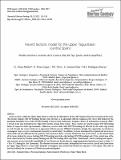Por favor, use este identificador para citar o enlazar a este item:
http://hdl.handle.net/10261/75919COMPARTIR / EXPORTAR:
 SHARE SHARE
 CORE
BASE CORE
BASE
|
|
| Visualizar otros formatos: MARC | Dublin Core | RDF | ORE | MODS | METS | DIDL | DATACITE | |

| Título: | Recent tectonic model for the Upper Tagus Basin (central Spain) |
Otros títulos: | Modelo tectónico reciente de la Cuenca Alta del Tajo (parte central española) | Autor: | Giner-Robles, Jorge L.; Pérez López, Raúl; Silva Barroso, Pablo Gabriel; Jiménez Díaz, Alberto CSIC ORCID ; Rodríguez-Pascua, M. A. CSIC ORCID | Palabras clave: | Seismotectonics Focal mechanisms Paleoseismicity Pleistocene Upper Tagus Basin |
Fecha de publicación: | jun-2012 | Editor: | Universidad Complutense de Madrid | Citación: | Giner-Robles, J. L., Pérez-López, R., Silva, P. G., Jiménez-Díaz, A., & Rodríguez-Pascua, M. A. (2012). Recent tectonic model for the Upper Tagus Basin (central Spain). Journal of Iberian Geology, 38(1). doi:10.5209/rev_JIGE.2012.v38.n1.39208 | Resumen: | Active tectonics within the Upper Tagus Basin is related to the lithospheric flexure affecting the Palaeozoic basement of the basin. This flexure displays NE-SW trending. Besides, this structure is in agreement with the regional active stress field defined by the maximum horizontal stress with NW-SE trending. In this tectonic framework, irregular clusters of instrumental seismicity (Mw< 5.0) fade in the zone bounded by the Tagus River and the Jarama River valleys. These clusters are related to major NW-SE trending faults of suspected strike-slip kinematics. Moreover, reverse faults with NE-SW trending are affected by the strike-slip system as well. Despite the reverse faults are in agreement with the present SHMAX orientation, though, they apparently are blocked as seismogenic sources (scarce instrumental seismicity recorded today). In addition, we have determined the regional and local stress/ strain fields and two different fracture patterns were observed. Hence, we have divided the area in two zones: (1) the lateral bands of the basin, defined by reverse faulting (NE-SW trending) and strike-slip faulting (NW-SE trending) and (2) the central zone of the basin characterized by shallow normal faulting and NE-SW trending strike-slip faults. Furthermore, surface faulting and liquefaction structures are described affecting Middle to Late Pleistocene fluvial deposits, suggesting intrabasinal palaeoseismic activity (5.5 < M < 6.5) during the Late Quaternary. The obtained structural and tectonic information has been used to classify and characterize the Upper Tagus Basin as a semi-stable intraplate seismogenic zone, featured by Pleistocene slip-rates < 0.02 mm/yr. This value is low but it affords the occurrence of Pleistocene paleoearthquakes. | Versión del editor: | http://dx.doi.org/10.5209/rev_JIGE.2012.v38.n1.39208 | URI: | http://hdl.handle.net/10261/75919 | DOI: | 10.5209/rev_JIGE.2012.v38.n1.39208 | ISSN: | 1698-6180 | E-ISSN: | 1886-7995 |
| Aparece en las colecciones: | (IGEO) Artículos (IGME) Artículos |
Ficheros en este ítem:
| Fichero | Descripción | Tamaño | Formato | |
|---|---|---|---|---|
| JIG_2012_38_1_113.pdf | 7,07 MB | Adobe PDF |  Visualizar/Abrir |
CORE Recommender
SCOPUSTM
Citations
8
checked on 18-abr-2024
WEB OF SCIENCETM
Citations
9
checked on 23-feb-2024
Page view(s)
395
checked on 19-abr-2024
Download(s)
405
checked on 19-abr-2024
Google ScholarTM
Check
Altmetric
Altmetric
NOTA: Los ítems de Digital.CSIC están protegidos por copyright, con todos los derechos reservados, a menos que se indique lo contrario.
